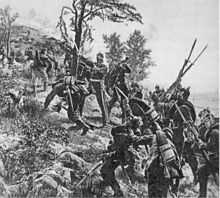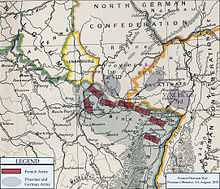Battle of Spicheren
| Battle of Spicheren | |||||||
|---|---|---|---|---|---|---|---|
| Part of the Franco-Prussian War | |||||||
 French and German positions at 6 PM on 6 August 1870 | |||||||
| |||||||
| Belligerents | |||||||
|
|
| ||||||
| Commanders and leaders | |||||||
| Karl Friedrich von Steinmetz | Charles Auguste Frossard | ||||||
| Strength | |||||||
| 37,000[1] | 29,000[1] | ||||||
| Casualties and losses | |||||||
| 4,871 killed and wounded[1] | 4,000 killed and wounded[1] | ||||||
The Battle of Spicheren, also known as the Battle of Forbach, was a battle during the Franco-Prussian War. The German victory compelled the French to withdraw to the defenses of Metz. The Battle of Spicheren, on 5 August, was the second of three critical French defeats. Moltke had originally planned to keep Bazaine's army on the Saar River until he could attack it with the 2nd Army in front and the 1st Army on its left flank, while the 3rd Army closed towards the rear. The aging General von Steinmetz made an overzealous, unplanned move, leading the 1st Army south from his position on the Moselle. He moved straight toward the town of Spicheren, cutting off Prince Frederick Charles from his forward cavalry units in the process.
Background

Moltke was pressing on with the concentration of the Prussian armies. His forces now formed two wings. On the right, the Second Army under Frederick Charles containing the III, IV, IX, X, XII Corps, and the Prussian Guard, was advancing from the Rhine River towards Saarbrücken, while the First Army under General Steinmetz with the I, VII and VIII Corps were moving into line with the Second Army from the direction of the lower Moselle River towards Saarlouis, in all both armies numbered some 185,000 men.
Prelude
Rotherberg

By this time, General Constantin von Alvensleben, commander of the III Corps of the German II Army under Prince Friedrich Karl of Prussia came to the aid of their compatriots leading units that had arrived on the scene. He assumed overall command and immediately began assessing the situation. Alvensleben decided to attack Frossard's left flank. With a combination of overlapping infantry and artillery attacks, the Prussians were able to roll the flank, thus gaining control of the Rotherberg Hill. By 9 o'clock, the French had given up the entire plateau outside Spicheren to the Prussians. Frossard had ordered a retreat towards Moselle where he planned to withdraw and move to the fortress of Verdun, but once again he was attacked by Steinmetz at the Battle of Borny-Colombey. On the way there they ran into Bazaine's division coming to reinforce them.
On the French side, planning after the disaster at Wissembourg had become essential. General Le Bœuf, flushed with anger, was intent upon going on the offensive over the Saar and countering their loss. However, planning for the next encounter was more based upon the reality of unfolding events rather than emotion or pride, as Intendant General Wolff told him and his staff that supply beyond the Saar would be impossible. Therefore, the armies of France would take up a defensive position that would protect against every possible attack point, but also left the armies unable to support each other.[2]
The battle was not intended by Moltke, who wished to keep Bazaine's army on the Saar River until he could attack it with the II army in front and the I army on its left flank, while the third army was closing towards its rear. The aging General Karl von Steinmetz made an overzealous, unplanned move, and proved that he did not have the slightest notion regarding Moltke's plans. Leading the I army south from his position on the Moselle, he moved straight toward the town of Spicheren, cutting off Prince Frederick Charles from his forward cavalry units in the process. The First Army advance guard (14th Division, VII Corps) under General Arnold Karl von Kameke, advancing on west from Saarbrücken on the morning of 6 August, found the bridges still intact, and seeing the opportunity that this offered, pushed on to occupy the high ground just beyond the town. The French 2nd Corps under Frossard, who had withdrawn his 2nd Corps back about one mile to the Spicheren plateau, had abandoned these heights in order to take up what he considered to be a position magnifique, fortified between Spicheren and Forbach. Frossard distributed his corps as follows: holding the right and centre was the division of General Laveaucoupet, deployed along the heights, with two companies entrenched on the Rotherberg. On the left General Vergé’s division occupied Stiring and the Forbach valley. General Bataille’s division was held back in reserve around Spicheren; in all, counting the corps cavalry and artillery, some 27,000 men with 90 guns.
Battle

While the French army under General MacMahon engaged the German 3rd Army at the Battle of Wörth, the German 1st Army under Steinmetz finished their advance west from Saarbrücken. A patrol from the German 2nd Army under Prince Friedrich Karl of Prussia spotted decoy fires close and Frossard's army farther off on a distant plateau south of the town of Spicheren, and took this as a sign of Frossard's retreat. Ignoring Moltke's plan again, both German armies attacked Frossard's French 2nd Corps, fortified between Spicheren and Forbach[3]
The French were unaware of German numerical superiority at the beginning of the battle as the German 2nd Army did not attack all at once. Treating the oncoming attacks as merely skirmishes, Frossard did not request additional support from other units. By the time he realized what kind of a force he was opposing, it was too late. Seriously flawed communications between Frossard and those in reserve under Bazaine slowed down so much that by the time the reserves received orders to move out to Spicheren, German soldiers from the 1st and 2nd armies had charged up the heights.[4] Because the reserves had not arrived, Frossard erroneously believed that he was in grave danger of being outflanked as German soldiers under General von Glume were spotted in Forbach. Instead of continuing to defend the heights, by the close of battle after dusk he retreated to the south. The German casualties were relatively high due to the advance and the effectiveness of the chassepot rifle. They were quite startled in the morning when they had found out that their efforts were not in vain, Frossard had abandoned his position on the heights.[5]
Kameke thought he would be engaging the rear guard of Frossard’s Corps, which he believed was in retreat. He ordered a full attack, committing his two brigades under Gen. Francois into the walls of hills running between Spicheren and Forbach. Francois's attack had stopped cold by one o'clock. He would sit and wait for reinforcements, wondering all the while just how many French were in front of him. Lucky for him, every French attempt at a counter-attack was stopped by his artillery. Kameke's 28th Brigade under von Woyna would arrive in late afternoon and bring the battle back to life again, but the Prussian attack would again be repulsed. The French would now counter-attack. Gen. Laveaucoupet's 40th Regiment pushed back Francois badly demoralized surviving troops while Gen. Charles Vergé's 2nd Brigade attacked Woyna's troops, pushing them back almost to Saarbrücken. If Frossard had pursued these counter-attacks he might have won the battle.
Aftermath
Analysis
France had lost another battle; the quality of its military commanders and their lack of initiative mainly to blame. The German casualties were relatively high due to lack of planning and the effectiveness of the French chassepot rifle.
Commemoration

There are numerous memorials on the various military cemeteries, many of them German, in Spicheren, commemorating the fallen soldiers or officers of the individual formations, as well as a big memorial for the fallen French. Many of these memorials became a theme for postcards in the decades after the battle. In the 21st century, groups from France and Germany regularly collaborate to re-enact the battle.[6]
See also
Footnotes
- ↑ 1.0 1.1 1.2 1.3 Henderson, p. 715-9 provides a table of returns for numerous "great battles," excluding prisoners.
- ↑ Howard 1961, pp. 87–88.
- ↑ Howard 1961, pp. 89–90.
- ↑ Howard 1961, pp. 92–93.
- ↑ Howard 1961, pp. 98–99.
- ↑ "Traditionsvereine führen Schlacht auf dem Spicherer Berg auf". Saarbrücker Zeitung (in German). 4 August 2010. Retrieved 16 October 2012.
References
- Howard, M. (1961). The Franco–Prussian War. London: Rupert Hart-Davis. ISBN 0-24663-587-8.
External links
| Wikimedia Commons has media related to Battle of Spicheren. |
- Compton's Home Library: Battles of the World CD-ROM
- http://homepages.paradise.net.nz/mcnelly/vb/scenarios/spicheren.htm
- Henderson, G.F.R. Stonewall Jackson and the American Civil War. Longmans, Green and Co. 1949